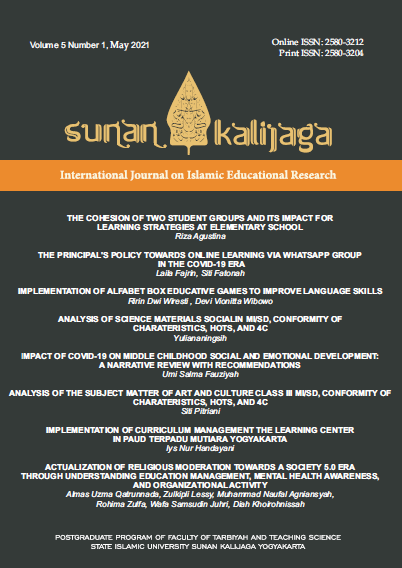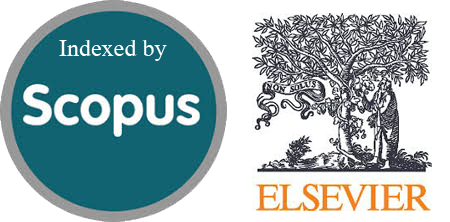THE COHESION OF TWO STUDENT GROUPS AND ITS IMPACT FOR LEARNING STRATEGIES AT ELEMENTARY SCHOOL
DOI:
https://doi.org/10.14421/skijier.2021.51.01Keywords:
group cohesiveness, independent group, teacher formation group, learning strategies, elementary schoolAbstract
Group cohesiveness is usually an interesting object of study in the context of social life and work management. However, cohesiveness can also be found in educational study areas. This study aims to determine the cohesiveness of the students of SD Negeri 2 Prambanan, find out the differences in cohesiveness between the independent groups and teacher formation groups, and the impact of the cohesiveness on the learning strategies. The quantitative methods are used to measure and to compare cohesiveness between the two groups using a t-test. The qualitative methods are used to narrate how teachers implement learning strategies according to student cohesiveness. The cohesiveness refers to the concept of Forsyth, which divides into the social, task, perceived, and emotional. This study finds that first, the group cohesiveness of students is in a moderate position. Second, the independent groups have significantly higher than the teacher formation groups. Third, there are five follow-ups in learning strategies undertaken by the teacher, i.e. rearranging student seats, making students who have high group cohesiveness as group leaders, motivating students who have low cohesiveness to be actively involved in their groups, giving freedom to groups to compete, and applying various collaborative
Downloads
References
Abdillah, Fuad. “Hubungan Kohesivitas Kelompok Dengan Intensi Turnover Pada Karyawan.” Journal of Social and Industrial Psychology 1, no. 2 (2012): 52–58.
Afifatun, Nisa, and Juneman. “Peran Mediasi Persepsi Kohesi Sosial Dalam Hubungan Prediktif Persepsi Pemanfaatan Ruang Terbuka Publik Terhadap Kesehatan Jiwa.” Makara Sosial Humaniora 16, no. 2 (2012): 89–100.
Arifin, Bambang Syamsul. Dinamika Kelompok. Bandung: Pustaka Setia, 2015.
Armansyah P, Raja. “Pengaruh Kepemimpinan Melayani, Kohesivitas Kelompok, Dan Efikasi Diri Terhadap Intensi Keluar Karyawan PT. QL Agrofood.” UGM Yogyakarta, 2017.
Azwar, Saifuddin. Penyusunan Skala Psikologi. Yogyakarta: Pustaka Pelajar, 2009.
Baron, Robert A, and Donn Byrne. Psikologi Sosial. Jakarta: Erlangga, 2003.
Beam, Myra M. “Emotional Intelligence and Team Cohesiveness.” A thesis submitted to the Graduate College of Marshall University (2012): 1–38.
Beri, Nimisha, and Abdul Baseer Safi. “Group Cohesion, Motivation and Self Confidence in L2 Classes: A Meta-Analysis.” International Refereed Journal of Reviews and Research 6, no. 2 (2018): 10–26.
Carron, Albert V, Mark A Eys, and Steven R Bray. “Team Cohesion and Team Success in Sport.” Journal of Sports Sciences 20, no. March 2002 (2002): 121–126.
Carron, Albert V, W. N Widmeyer, and L.R Brawley. “The Development of an Instrument to Assess Cohesion in Sport Teams : The Group Environment Questionnaire.” Journal Of Sport Psychology 7 (1985): 244–266.
Chang, Artemis, Julie Duck, and Prashant Bordia. “Group Cohesion And Performance.” Physics Letters B 37, no. 3–4 (2006): 1–34.
Chin, Wynne W, Matthew J Stollak, WM. David Salisbury, and Allison W Pearson. “Perceived Cohesion in Small Groups Adapting and Testing the Perceived Cohesion Scale in a Small-Group Setting.” Small Goup Research 30, no. No. 6 December (1999): 751–766.
Djaali, H. Psikologi Pendidikan. Jakarta: PT Bumi Aksara, 2013.
Eys, Mark A, Todd Lougheed, Steven R Bray, and Albert V Carron. “Development of a Cohesion Questionnaire for Youth: The Youth Sport Environment Questionnaire Sport Environment Questionnaire.” Journal of Sport and Exercise Psychology 31 (2009): 390–408.
Forsyth, Donelson R. Group Dynamics 5th Edition. USA: Cenggage Learning, 2010.
Herawaty, Ermy. “Penerapan Developmental Peer Appraisal Untuk Meningkatkan Kohesivitas Kelompok Tugas.” Universitas Gadja Mada, 2015.
Huraerah, Abu, and Purwanto. Dinamika Kelompok Konsep Dan Aplikasi. Bandung: Refika Aditama, 2006.
Ikbar, Febri Nurrahmi, and Hamdani M. Syam. “Kohesivitas Pada Kelompok Jamaah Tabligh.” Jurnal Komunikasi Global 8, no. 2 (2019).
Inelda, Alexandriani. “Pelatihan Kepercayaan Interpersonal Untuk Meningkatkan Kohesivitas Tim.” Universitas Gadja Mada, 2011.
Kodri, Mohtana Kharisma. “Hubungan Karakteristik Sosial Ekonomi Penghuni Serta Fisik Perumahan Pinggir Kota Dan Tingkat Kohesivitas Sosial.” Universitas Gadjah Mada, 2013.
Marcel, Pomohaci, and Sopa Ioan Sabin. “Group Cohesion Important Factor In Sport Performance.” European Scientific 10, no. 26 (2014): 163–174.
Marina Putri, Mirza. “Kohesivitas Kelompok Dan Kualitas Kehidupan Kerja Pada Karyawan.” Jurnal Psikologi Insyiah 1, no. 1 (2018): 1–17.
McLeod, Janet, and Kathryn Von Treuer. “Toward a Cohesive Theory of Cohesion.” International Journal of Business and Social Research 3, no. 12 (2013).
Munandar. Psikologi Industri Dan Organisasi. Jakarta: UI Press, 2001.
Muskania, Ricka Tesi. “Analysis of Class Teacher Difficulties in Thematic Learning at Madrasah Ibtidaiyah.” Al Ibtida: Jurnal Pendidikan Guru MI 6, no. 2 (2019): 231.
Pescosolido, Anthony T, and Richard Saavedra. “Cohesion and Sports Teams A Review.” Small Group Research 43, no. No 6 (2012).
Prayogo, Vira Setya. “Pengaruh Dukungan Organisasional Dan Kohesivitas Kelompok Persepsian Terhadap Keterikatan Oranisasional Pada Perawat.” Universitas Gadjah Mada, 2015.
Qomaria, Nurul, Muhammad Al Musadieq, and Heru Susilo. “Peranan Kohesivitas Kelompok Untuk Menciptakan Lingkungan Kerja Yang Kondusif (Studi Pada PT Panca Mitra Multi Perdana Situbondo).” Jurnal Administrasi Bisnis 29, no. 1 (2015): 77–85.
Safitri, Anfa, and Sonny Andrianto. “Hubungan Antara Kohesivitas Dengan Intensi Perilaku Agresi Pada Suporter Sepak Bola.” Jurnal Psikologi Islami 1, no. 2 (2015): 11–23.
Setiawati, Esti, and Ika Ernawati. “The Evaluation of Students’ Prosocial Behavior on Primary Education Level.” Al-Bidayah: Jurnal Pendidikan Dasar Islam 11, no. 2 (2019): 2019.
Trihapsari, Vivia R, and Fuad Nashori. “Kohesivitas Kelompok Dan Komitmen Organisasi Pada Finacial Advisor Asuransi X Yogyakarta.” Proyeksi 6, no. 2 (2011): 12–20.
Walgito, Bimo. Psikologi Kelompok. Yogyakarta: Andi, 2008.
Wibowo, Arief. “Pengaruh Persepsi Individu Tentang Kohesivitas Kelompok Kerja Dan Motivasi Kerja Terhadap Kinerja Auditor BPK RI.” Universitas Gadjah Mada, 2012.










